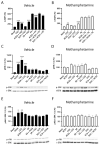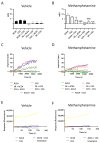Methamphetamine Blocks Adenosine A2A Receptor Activation via Sigma 1 and Cannabinoid CB1 Receptors
- PMID: 33803075
- PMCID: PMC7963146
- DOI: 10.3390/ijms22052743
Methamphetamine Blocks Adenosine A2A Receptor Activation via Sigma 1 and Cannabinoid CB1 Receptors
Abstract
Methamphetamine is, worldwide, one of the most consumed drugs of abuse. One important side effect is neurodegeneration leading to a decrease in life expectancy. The aim of this paper was to check whether the drug affects one of the receptors involved in neurodegeneration/neuroprotection events, namely the adenosine A2A receptor (A2AR). First, we noticed that methamphetamine does not affect A2A functionality if the receptor is expressed in a heterologous system. However, A2AR becomes sensitive to the drug upon complexes formation with the cannabinoid CB1 receptor (CB1R) and the sigma 1 receptor (σ1R). Signaling via both adenosine A2AR and cannabinoid CB1R was affected by methamphetamine in cells co-expressing the two receptors. In striatal primary cultures, the A2AR-CB1R heteromer complex was detected and methamphetamine not only altered its expression but completely blocked the A2AR- and the CB1R-mediated activation of the mitogen activated protein kinase (MAPK) pathway. In conclusion, methamphetamine, with the participation of σ1R, alters the expression and function of two interacting receptors, A2AR, which is a therapeutic target for neuroprotection, and CB1R, which is the most abundant G protein-coupled receptor (GPCR) in the brain.
Keywords: G protein-coupled receptor GPCR; drug of abuse; heteromer; neuroprotection; striatal neurons.
Conflict of interest statement
The authors declare no conflict of interest. The funders had no role in the design of the study; in the collection, analyses, or interpretation of data; in the writing of the manuscript, or in the decision to publish the results.
Figures






Similar articles
-
Singular Location and Signaling Profile of Adenosine A2A-Cannabinoid CB1 Receptor Heteromers in the Dorsal Striatum.Neuropsychopharmacology. 2018 Apr;43(5):964-977. doi: 10.1038/npp.2017.12. Epub 2017 Jan 19. Neuropsychopharmacology. 2018. PMID: 28102227 Free PMC article.
-
Comparing adenosine A2A receptor modulation of cannabinoid CB1 receptor-mediated inhibition of GABA and glutamate release in rodent striatal nerve terminals.Eur J Neurosci. 2025 Jan;61(1):e16642. doi: 10.1111/ejn.16642. Eur J Neurosci. 2025. PMID: 39777752
-
Striatal adenosine-cannabinoid receptor interactions in rats over-expressing adenosine A2A receptors.J Neurochem. 2016 Mar;136(5):907-17. doi: 10.1111/jnc.13421. Epub 2015 Nov 24. J Neurochem. 2016. PMID: 26526685
-
Allosteric mechanisms within the adenosine A2A-dopamine D2 receptor heterotetramer.Neuropharmacology. 2016 May;104:154-60. doi: 10.1016/j.neuropharm.2015.05.028. Epub 2015 Jun 4. Neuropharmacology. 2016. PMID: 26051403 Free PMC article. Review.
-
Presynaptic adenosine receptor heteromers as key modulators of glutamatergic and dopaminergic neurotransmission in the striatum.Neuropharmacology. 2023 Feb 1;223:109329. doi: 10.1016/j.neuropharm.2022.109329. Epub 2022 Nov 11. Neuropharmacology. 2023. PMID: 36375695 Review.
Cited by
-
Consecutive treatments of methamphetamine promote the development of cardiac pathological symptoms in zebrafish.PLoS One. 2023 Nov 17;18(11):e0294322. doi: 10.1371/journal.pone.0294322. eCollection 2023. PLoS One. 2023. PMID: 37976248 Free PMC article.
-
Nanowired Delivery of Mesenchymal Stem Cells with Antioxidant Compound H-290/51 Reduces Exacerbation of Methamphetamine Neurotoxicity in Hot Environment.Adv Neurobiol. 2023;32:317-352. doi: 10.1007/978-3-031-32997-5_8. Adv Neurobiol. 2023. PMID: 37480465
References
MeSH terms
Substances
Grants and funding
LinkOut - more resources
Full Text Sources
Other Literature Sources
Medical

